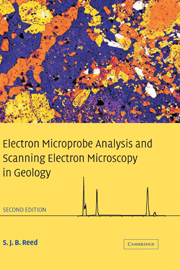1 - Introduction
Published online by Cambridge University Press: 03 December 2009
Summary
Electron microprobe analysis
Electron microprobe analysis (EMPA) is a technique for chemically analysing small selected areas of solid samples, in which X-rays are excited by a focussed electron beam. (The term ‘electron probe microanalysis’, or EPMA, is synonymous.) The X-ray spectrum contains lines characteristic of the elements present; hence a qualitative analysis is easy to obtain by identifying the lines from their wavelengths (or photon energies). By comparing their intensities with those emitted from standard samples (pure elements or compounds of known composition) it is also possible to determine the concentrations of the elements quantitatively. Accuracy approaching ± 1% (relative) is obtainable and detection limits down to tens of parts per million (by weight) can be attained. Under normal conditions, spatial resolution is limited to about 1 μm by the spreading of the beam within the sample. The spatial distributions of specific elements can be recorded in the form of line profiles or two-dimensional ‘maps’, which are commonly displayed using a ‘false’ colour scale to represent elemental concentrations.
Scanning electron microscopy
The scanning electron microscope (SEM) is a close relative of the electron microprobe (EMP) but is designed primarily for imaging rather than analysis. Images are produced by scanning the beam while displaying the signal from an electron detector on a TV screen or computer monitor. By choosing the appropriate detection mode, either topographic or compositional contrast can be obtained. (‘Composition’ here refers to mean atomic number: individual elements cannot be distinguished.)
Information
- Type
- Chapter
- Information
- Publisher: Cambridge University PressPrint publication year: 2005
